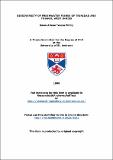Files in this item
Biodiversity of freshwater fishes of Trinidad and Tobago, West Indies
Item metadata
| dc.contributor.advisor | Alkins-Koo, Mary | |
| dc.contributor.advisor | Magurran, Anne E. | |
| dc.contributor.advisor | Ramnarine, Indar | |
| dc.contributor.author | Phillip, Dawn Arlene Teresa | |
| dc.coverage.spatial | 174 | en_US |
| dc.date.accessioned | 2012-06-21T09:56:55Z | |
| dc.date.available | 2012-06-21T09:56:55Z | |
| dc.date.issued | 1998 | |
| dc.identifier | uk.bl.ethos.516148 | |
| dc.identifier.uri | https://hdl.handle.net/10023/2832 | |
| dc.description.abstract | The proximity of the speciose South American continent to Trinidad and Tobago ensures that these islands have a rich and dynamic fauna. According to the equilibrium theory of island biogeography (MacArthur & Wilson 1967), these islands should be subjected to frequent immigrations from the nearby continent, and these additions will, in response, fuel local extinctions to maintain a balance of species richness. The aquatic habitat is further impacted by man's activities, (Government of Trinidad and Tobago 1962; Government of Trinidad and Tobago 1976b) which have the potential to amplify the natural rates of immigration and extinction. Despite the possible consequences, the effects of this disturbance on the fish fauna have not been studied. A survey of the islands' freshwater fishes was therefore carried out to investigate the natural spatial and temporal dynamics of local fish communities, and the effects of anthropogenic perturbations, on these. These baseline data can be used as a benchmark to address some of the problems that are threatening the fish diversity of Trinidad and Tobago. The fish fauna of Trinidad and Tobago is diverse. Total species richness was estimated at between 37 and 40. Four zoogeographic zones were recognised. A zone of Antillean fishes included Tobago and the north coast of Trinidad. A zone of recent colonising South American fauna existed along the south coast of Trinidad. The rest of Trinidad contained a relict South American fauna dating back to the time when Trinidad was still part of the mainland. Included here was a centrally located zone of unstable fauna at risk of local extinction. The fish fauna was temporally dynamic due to frequent colonisation and extinction events. Examination of the historic record showed that observed species richness varied from 38 to 43 between the mid 1950s and the present. During this time there were 15 introductions and 12 local extinctions. A conservative estimate was that a new species was recorded for Trinidad almost every three years. The geographic distribution of species also showed temporal changes which indicated a natural tendency of the fauna to vary over time. Human interference, particularly the introduction of exotic fish species and long-term habitat alteration, has affected species diversity. Forty seven percent of the new introductions and 43% of the extinctions were human-introduced exotics. About four fifths of sites in Trinidad, and almost one fifth of the sites in Tobago, were either perturbed or polluted. Polluted rivers coincided with areas of high urbanisation and industrial development in the west and southwest of Trinidad. Several effects of human interference on the fauna were recorded. Almost 8% of the sites examined contained one of the three exotic species still extant on the island. At each of these sites, the exotic species accounted for between 1.3% and 80.4%, by number, of the fish caught. Some of the effects of habitat disturbance on individual sites were increased frequency of diseases, extirpation of species, changes in species richness and other diversity measures, and the eventual regression of the fish community to opportunistic species (r-strategists). The potential of two fishes, Poecilia reticulata and Astyanax bimaculatus, as indicator species was examined. Astyanax showed better potential as an indicator of habitat quality as it was not found in depauperate communities, typical of severely disturbed habitats, and its proportional abundance and biomass were negatively affected by pollution. Poecilia populations, on the other hand, were found to be insensitive to habitat quality when the above-mentioned criteria were used. They did, however, have a high frequency of diseased individuals at polluted sites. One of the aims of conservation is to protect that portion of biodiversity most at risk of extinction, the rare species (Rabinowitz 1986). Over 70% of freshwater fish species found in Trinidad and Tobago were classified as rare in these islands. This fact, in addition to the loss of diversity recorded for some sites indicates that the implementation of a management strategy for the conservation of the freshwater fish fauna of Trinidad and Tobago is imperative. The management strategy should focus on the amelioration and protection of aquatic habitats since at least 80% of the rare species had either a restricted geographic distribution or narrow habitat specificity. Additionally, protection from overexploitation should be offered to commercially important species with only small populations. Finally, a minimum sample size of 35 sites, spread over different zoogeographic areas, is recommended for estimating species richness for monitoring, an intrinsic part of any management strategy. | en_US |
| dc.language.iso | en | en_US |
| dc.publisher | University of St Andrews | |
| dc.subject.lcc | QL621.58P5 | |
| dc.subject.lcsh | Fishes--Caribbean Area--Identification | en_US |
| dc.title | Biodiversity of freshwater fishes of Trinidad and Tobago, West Indies | en_US |
| dc.type | Thesis | en_US |
| dc.type.qualificationlevel | Doctoral | en_US |
| dc.type.qualificationname | PhD Doctor of Philosophy | en_US |
| dc.publisher.institution | The University of St Andrews | en_US |
This item appears in the following Collection(s)
Items in the St Andrews Research Repository are protected by copyright, with all rights reserved, unless otherwise indicated.

